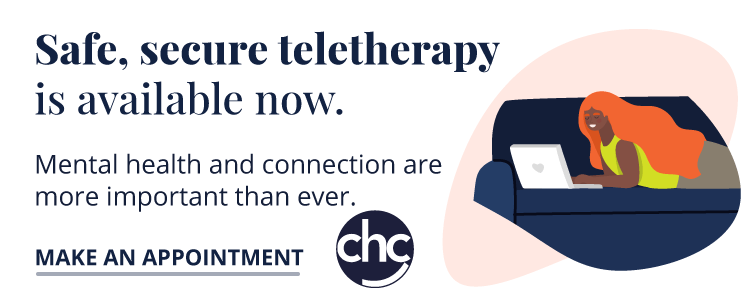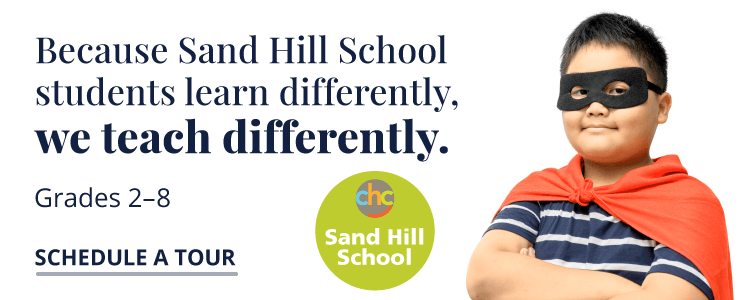November 17, 2021
Cindy Lopez:
Welcome to Voices of Compassion, CHC’s podcast series providing courage, connection and compassion, highlighting topics that matter to our community, our parents, families, educators and other professionals. My name is Cindy Lopez. You know it seems like everyone is talking about mindfulness these days. As a matter of fact, I did a Google search and the results showed 9 ways to practice mindfulness, 16 types of meditation and 28 ways to practice mindfulness for beginners. There’s so much out there. So what is mindfulness really and does it make a difference? Do I have to empty my head of all my thoughts and sit criss-crossed on the floor in a zen type state? Uh, not so much. Listen in to this podcast episode, as we talk with Jennifer Solomon, occupational therapist at CHC about the physiology of mindfulness and address some of the skeptics questions. Welcome Jen.
I’m just wondering if there’s anything that you’d like to share with our listeners as we get started today.
Jennifer Salomon OTD, OTR/L:
So, if there’s anything I want people to take home today it’s that mindfulness can be done by anybody, at any time, anywhere, and hopefully our conversation today debunks some of those skeptic thoughts.
Cindy Lopez:
Thanks so much, Jen. We hear the term mindfulness so much right now and because it’s such a great strategy for dealing with stress and anxiety. So, let’s talk about what is mindfulness and are mindfulness and meditation the same, or are they different?
Jennifer Salomon OTD, OTR/L:
This is such a good question because I think a lot of the times both terms are used interchangeably, and I think a lot of the confusion comes from them being in the same realm and their goals are the same, right. We want inner peace, we want to feel a little bit more focused, we want to more regulated and that’s the end goal for both of these practices. So I think the difference is that mindfulness is simply the act of paying attention. It’s purposeful, it’s nonjudgmental, but it can be done anytime, anywhere. It could be done when we’re in the car driving to work, it could be done when we are brushing our teeth or when we’re in conversation with somebody and even when we’re taking a walk. Something I’ve thought about recently is that a lot of what we do on a day-to-day basis is not necessarily mindful, but mindless. Sometimes we end up at work and we’re like, how did I get here, like what turns did I take, right? And I think that’s just a prime example of how sometimes we can be paying attention, but not really truly paying attention to what we’re doing.
Cindy Lopez:
That’s so funny because I do that when you said, so much of what we do is mindless. I totally pull out of my driveway and drive down the street, and think did I close the garage door? It’s so automatic. I don’t even think about it, right. So how does mindfulness work, Jen? I’ve heard that it’s kind of like exercising a muscle. What do you think about that?
Jennifer Salomon OTD, OTR/L:
Yeah, I totally agree. If we think about exercising or even learning something novel like as an OT learning how to walk right or learning how to ride a bike, or even learning to throw a ball. At the first few times we might not get it, and it might feel awkward, it might feel uncomfortable, but the more we do it, we’re building those brain body connections. And we’re learning what it feels like to experience that and the more we practice it, the more we make those brain body connections stronger and that brain circuitry stronger and eventually the longer we do it, the more we do it, it just becomes part of us. It becomes the way we think, the way we navigate our day-to-day tasks, and I definitely think it gets stronger with time. It gets stronger with practice and it’s not always going to be perfect. There are things that we can’t necessarily always tune in when there’s something stressful going on, but the hope is that we’re bringing more awareness each time we’re doing some thing.
Cindy Lopez:
Yeah and I think that a common misperception is you’re sitting there cross-legged on the floor in this zen state, right, kind of blissing out or, you know, it’s not all unicorns and rainbows, but it is exercising your muscle. It is learning something new, and sometimes that can feel a little awkward and maybe not all pleasant to start with anyway, but hopefully you’re building a brain that’s more resilient. I’m just wondering if you know of any research or what’s happening in the brain as we exercise mindfulness?
Jennifer Salomon OTD, OTR/L:
The research has shown that there are physiological changes and structural changes to the brain. The research has shown that there are changes in brain regions that are associated with attention, with emotion, with sensory processing and overall body awareness, and if we think about all of these factors working together, we’re hopefully going to have an increased overall ability to self regulate, right. If we’re more in tune with what’s going on physiologically, hopefully we’re better able to identify and recognize and label what’s going on for us emotionally, and express that in an effective way.
Cindy Lopez:
From what I was reading mindfulness, that act of paying attention really in the moment and being present, it does really help to reduce stress and improve distress tolerance. So it does help with stress and anxiety. So if you do it and you really practice it and keep doing it, as you said, exercise that muscle, I think it can really make a difference for people. I think some people think that mindfulness doesn’t work for them. Well, I’ve tried that doesn’t really work for me. What thoughts do you have about?
Jennifer Salomon OTD, OTR/L:
So it’s important to think about the intention behind why we’re being mindful or the concept behind being mindful. And what is someone’s idea of something feeling successful. If it’s to feel better, it might not necessarily always turn out that way. Being mindful is not necessarily a route to feeling better or to feeling stress-free, it’s an act of identifying what’s going on there emotionally and physiologically, and what are we truly experiencing and sometimes that’s not always a positive experience. We’re really tuning into any discomfort or any comfort that we’re experiencing, and I think for individuals who say mindfulness doesn’t work for me, maybe we start with the things that we’re already doing on a day-to-day basis.
So the first thing we do when we wake up, where do our thoughts go? Are we thinking about oh, today’s Monday or Tuesday, I need to run to the grocery store or are we waking up and tuning into how we feel, how tired are we? How quiet, or how loud is the house? How bright is it outside? How restful do I feel as I get up? Do I need to stretch, those small shifts in the way we think and the way we navigate each part of our day is a way for us to be mindful and to try it without necessarily having to carve out 5, 10, 15 minutes of meditation. And I think there’s a difference between meditation and mindfulness there too. Meditation is truly an active practice of sitting down, carving out time and hoping to find some awareness with what thoughts are coming up, with what feelings are coming up, but mindfulness, we don’t necessarily have to go through that experience, but we can incorporate it throughout the day in the activities that we already do.
Cindy Lopez:
One size doesn’t fit all right. Just because you’ve tried mindfulness or a mindfulness exercise or practice that didn’t work for you, there could be others that resonate more with you. So I live in the mountains and sometimes when I’m driving, I have to stop myself and just take a look around. The place that I live and where we are is beautiful and the Redwood trees and the ocean that if I stop and really am mindful of that for a moment it changes my perspective, and I think that’s what you’re saying like it doesn’t take a whole meditation practice and carving out half an hour of your day or whatever. Also, I know there are apps out there that promote mindfulness and meditation. And a couple that I’m thinking about like Headspace or Calm. Do those work? What do you think about those?
Jennifer Salomon OTD, OTR/L:
I think for some people they’re great. The concept of co-regulation and thinking about the environment that we’re in and how that really shapes the internal states sometimes for some people, but some people can tune out the external and just tune right in, right. So I think for individuals who like that experience, that sensory experience of calming noise or someone’s voice guiding and nudging our thoughts in a mindful direction, sometimes that’s really helpful, but for other individuals who don’t necessarily need that direction or need that external cue, it might be distracting. So I think like you said, one size doesn’t necessarily fit all. It really comes down to what allows us to get into that space of tuning in and tuning into ourselves, but also tuning into our environment and what allows us to access the present moment.
Cindy Lopez:
Just a note before we continue on with today’s episode, we hope you’re following us on social media, so you don’t need to wait a whole week between episodes to get engaging, inspiring and educational content from CHC. Our social handles are linked on our podcast webpage at podcasts.chconline.org.
So Jen, a lot of times I hear as people are trying to practice mindfulness, like I don’t want to become less aware of the world and what’s going on around me if I get too much in my own head or as you referenced, like, it could take up too much of my time, or maybe it’s going to make me less productive because I’m spending all this time looking inward. What thoughts do you have about that or any comments you wanna make about that?
Jennifer Salomon OTD, OTR/L:
So mindfulness, I think at its core, like I said, it’s just paying attention, not necessarily to one thing or just ourselves, but to everything that’s going on within the present moment. So that might mean, wow this car’s honking very loudly at me, right. That might mean, I’m feeling very stressed within physiologically and exploring that it’s not necessarily tuning out what’s around us, it’s paying attention to objectively what’s going on. So I think the more awareness we’re bringing to that present moment as opposed to dwelling on those thoughts of wow, I could have done this differently earlier today, or I’m really worried about what’s going to happen tomorrow. Tuning into what’s going on right now, that doesn’t necessarily take away, if anything we’re contributing, right. Because we’re tuning into everything in our environment and the social experience and the more awareness we bring to that the more opportunities we have to affect change if there is change to be had. So we’re not necessarily, like you said, blissing out. We’re not growing complacent with everything around us. We’re bringing more attention to it if anything.
Cindy Lopez:
Yeah I like that and I think it also can make us more compassionate and more thoughtful of others because we’re taking a moment to just pay attention. And when we do that, we might see things with other people that we didn’t notice before, and it gives us an opportunity to perhaps reach out to them. I’m wondering if you can provide some practical ways to make mindfulness happen what strategies do you have? You’ve actually referenced in a previous podcast last season about some breathing techniques. Maybe you want to review some of those and share some other strategies.
Jennifer Salomon OTD, OTR/L:
Of course and I first off want to say that a meditation practice is wonderful for individuals who can access that, I encourage it. I myself don’t necessarily practice meditation on a consistent basis, but mindfulness, right. And so there are individuals who really have a habitual practice of meditation and that’s great, but for a lot of individuals that I’ve come across, it’s been written off as oh, that doesn’t work for me or the deep breathing doesn’t work, and a lot of the kids that I work with even say like deep breathing isn’t helpful for me And it’s not that they’re necessarily doing it the wrong way, but maybe it’s the way that we’re thinking and conceptualizing that experience. So one practical thing that I implement is getting up to stretch for 10 to 15 seconds and not just stretching, but in that moment we’re tuning into our body, what our muscles feel like, where does it feel good to stretch? What’s happening to our breath? Have we breathed deeply within the past hour? Which a lot of the times I catch myself and I haven’t. I haven’t allowed myself to breathe all of time through to my stomach, which is the breadth that is physiologically relaxing.
Another thing that I like to think about is what we do on a day-to-day basis, so eating, having a conversation with a loved one, drinking water or whatever beverage. What is the sensation? What are we seeing? What are we smelling? What are we tasting? What’s the texture like? A lot of the times we’re just go, go, go, right. Because in the society a lot of the times the goal is to get things done and with that we lose a lot of the internal experience of that process that we’re doing on a day-to-day basis. When it comes to conversations with people, how are they saying something? What’s the tone of voice? What’s their body language like? Are we thinking about the next thing we’re going to say or are we waiting and listening and truly reflecting before we respond? So there are countless opportunities for us to just be present. And I think the practice I encourage everyone to do is just think about what we already do, but in a different way.
Cindy Lopez:
Yeah, that common thread of attention to the present and even when you just said take a few seconds to get up and stretch and then do a little deep breathing, even when you said that I just sat back and did a deep breath because I thought, oh yeah, I haven’t done that today. And it’s amazing how it makes you just kind of pay attention a little bit more and all of a sudden your body, at least my body, just relaxes a little bit, feels different. That whole act of just paying attention to the present is the core of what’s happening as we think about mindfulness.
So Jen, just want to say thank you for being with us today. And I’m wondering if there’s any parting thoughts you’d like to share with our listeners as we wrap it up.
Jennifer Salomon OTD, OTR/L:
I read recently something along the lines of, as soon as we tune in and recognize that we’re not being mindful, we’re already being mindful, and I think that really brings it home for me. Just the moment that we realized we’re not paying attention is the moment we start paying attention.
Cindy Lopez:
Thank you. Good words to hear as we close our conversation and to our listeners, jen actually did an episode with us last season on mindfulness. And you can hear more from her in that episode and also to our listeners, thank you so much for joining us today and we hope you’ll join us again for our next episode.
Jennifer Salomon OTD, OTR/L:
Thank you, Cindy.
Cindy Lopez:
Find us online at podcasts.chconline.org. Also, please follow us on our socials. Find us on Facebook at chc.paloalto and Twitter and Instagram at CHC_paloalto. You can also visit our YouTube channel at chconlinepaloalto. And we are on LinkedIn. Subscribe to Voices of Compassion on Apple podcasts, Spotify and other podcast apps, and sign up for our virtual village email list so you never miss an update or an episode. I always love to hear from you so send me an email or a voice memo at podcasts@chconline.org or leave us a rating and review. We look forward to you tuning in each week.



